|
The Landing Place
The greatest Roman temple ruins lie not in Rome, but in the
mountains of Lebanon. They encompass a grand temple to Jupiter—the
grandest built anywhere in antiquity to honor any one God. Many
Roman rulers, over a period of some four centuries, toiled to
glorify this remote and alien place and erect its monumental
structures. Emperors and generals came to it in search of oracles,
to find out their fate. Roman legionnaires sought to be billeted
near it; the devout and the curious went to see it with their own
eyes: it was one of the wonders of the ancient world.
Daring European travelers, risking life and limb, reported the
existence of the ruins since the visit there by Martin Raumgarten in
January 1508. In 1751, the traveler Robert Wood, accompanied by the
artist James Dawkins, restored some of the place's ancient fame when
they described it in words and sketches.
"When we compare the ruins
... with those of many cities we visited in Italy, Greece, Egypt
and other parts of Asia, we cannot help thinking them the remains of
the boldest plan we ever saw attempted in architecture"—bolder in
certain aspects than even the great pyramids of Egypt.
The view upon
which Wood and his companion had come was a panorama in which the
mountaintop, the temples and the skies blended into one (Fig. 90).
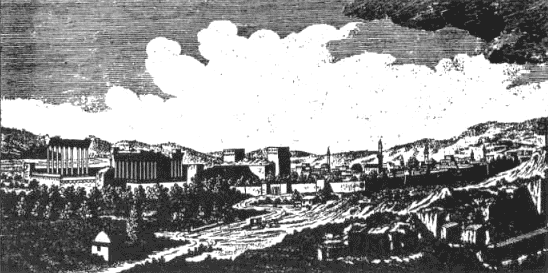
Fig. 90
The site is in the mountains of Lebanon, where they part to form a
fertile, flat valley between the "Lebanon" range to the west and the
"Anti-Lebanon" range to the east; where two rivers known from
antiquity, the Litani and the Orontes, begin to flow into the
Mediterranean Sea. The ruins were of imposing Roman temples that
were erected upon a vast horizontal platform, artificially created
at about 4,000 feet above sea level. The sacred precinct was
surrounded by a wall, which served both as a retaining wall to hold
the earthworks forming the flat top, as well as a fence to protect
and screen off the area. The enclosed squarish area, with some sides
almost 2,500 feet long, measured over five million square feet.
Situated so as to command the flanking mountains and the approaches
to the valley from north and south, the sacred area had its
northwestern corner deliberately cut off—as seen in this
contemporary bird's eye view (Fig. 91a).
The right-angled cutout created an oblong area, which extended the
platform's unimpeded northern view westward. It was at that
specially conceived corner that the vastest-ever temple to Jupiter
stood high, with some of the tallest (65 feet) and largest (7.5 feet
in diameter) columns known in antiquity. These columns supported an
elaborately decorated superstructure ("architrave") 16 feet in
height, atop which there was a slanting roof, further raising the
temple's pinnacle.
The temple proper was only the westernmost (and oldest) part of a
four-part shrine to Jupiter, which the Romans are believed to have
started to build soon after they occupied the place in 63 B.C.
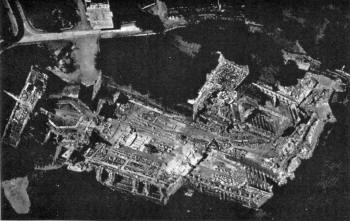
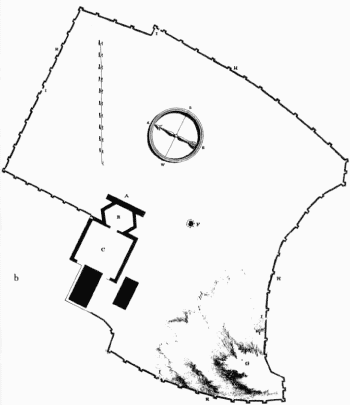
Fig. 91
Arranged along a slightly slanted east-west axis (Fig. 91b) were,
first, a monumental Gateway ("A"); it comprised a grand staircase
and a raised portico supported by twelve columns, in which there
were twelve niches to hold the twelve Olympian Gods. The worshippers
then entered a forecourt ("B") of an hexagonal design, unique in
Roman architecture; and through it continued to a vast altar court
("C"), which was dominated by an altar of monumental proportions: it
rose some 60 feet from a base of about 70 by 70 feet.
At the western
end of the court stood the God's house proper ("D"). Measuring a
colossal 300 by 175 feet, it stood upon a podium which was itself
raised some 16 feet above the level of the court—a total of 42 feet
above the level of the base platform. It was from that extra height
that the tall columns, the architrave and the roof made together a
real ancient skyscraper.
From its monumental gateway staircase to its final western wall, the
shrine extended for more than 1,000 feet in length. It completely
dwarfed a very large temple to its south ("E"), which was dedicated
to a male deity, some think Bacchus but probably Mercury; and a
small round temple ("F") to the southeast, where Venus was
venerated.
A German archaeological team that explored the site and
studied its history on orders of Kaiser Wilhelm II, soon after he
had visited the place in 1897, was able to reconstruct the layout of
the sacred precinct and prepared an artist's
rendering of what the ancient complex of temples, stairways,
porticoes, gateways, columns, courtyards and altars probably looked
like in Roman times (Fig. 92).
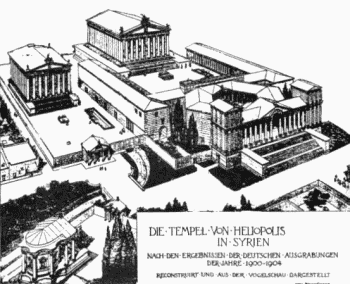
Fig. 92
A comparison with the renowned Acropolis of Athens will give one a
good idea of the scale of this Lebanese platform and its temples.
The Athens complex (Fig. 93) is situated upon a stepped ship-like
terrace less than 1,000 feet at its longest and about 400 feet at
its widest.
The stunning Parthenon (temple of Athena) which still
dominates the once sacred area and the whole plain of Athens is
about 230 by 100 feet—even smaller than the temple of
Mercury/Bacchus at the Lebanese Site.
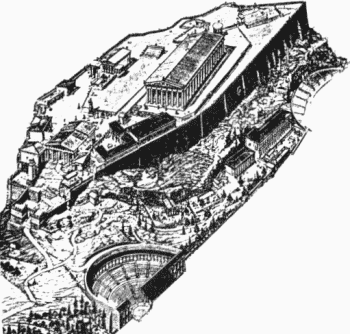
Fig. 93
Having visited the ruins, the archaeologist and architect Sir
Mortimer Wheeler wrote two decades ago:
"The temples ... owe
nothing of their quality to such new-fangled aids as concrete. They
stand passively upon the largest known stones in the world, and some
of their columns are the tallest from antiquity... . Here we have
the last great monument ... of the Hellenic world."
Hellenic world indeed, for there is no reason that any historian or
archaeologist could find for this gigantic effort by the Romans, in
an out-of-the-way place in an unimportant province, except for the
fact that the place was hallowed by the Greeks who had preceded
them. The Gods to whom the three temples were dedicated—Jupiter,
Venus and Mercury (or Bacchus)—were the Greek Gods Zeus, his sister
Aphrodite and his son Hermes (or Dionysus).
The Romans considered the site and its great temple as the ultimate
attestations of the almightiness and supremacy of Jupiter. Calling
him love (echo of the Hebrew Yehovah?), they inscribed upon the
temple and its main statue the divine initials I.O.M.H.—the legend
standing for Iove Optimus Maximus Heliopolitanus: the Optimal and
Maximal Jupiter the Heliopolitan.
The latter title of Jupiter stemmed from the fact that though the
great temple was dedicated to the Supreme God, the place itself was
considered to have been a resting place of Helios, the Sun God who
could traverse the skies in his swift chariot. The belief was
transmitted to the Romans by the Greeks, from whom they also adopted
the name of the place: Heliopolis. How the Greeks had come to so
name the place, no one knows for sure; some suggest that it was so
named by Alexander the Great.
Yet Greek veneration of the place must have been older and deeper
rooted, for it made the Romans glorify the place with the greatest
of monuments, and seek there the oracle's word concerning their
fate. How else to explain the fact that, "in terms of sheer acreage,
weight of stone, dimensions of the individual blocks, and the amount
of carving, this precinct can scarcely have had a rival in the
Graeco-Roman world" (John M. Cook, The Greeks in Ionia and the
East).
In fact, the place and its association with certain Gods go back to
even earlier times. Archaeologists believe that there may have been
as many as
six temples built on the site before Roman times; and it is certain
that whatever shrines the Greeks may have erected there, they—as the
Romans after them—were only raising the structures atop earlier
foundations, religiously and literally.
Zeus (Jupiter to the
Romans), it will be recalled, arrived in Crete from Phoenicia
(today's Lebanon), swimming across the Mediterranean Sea after he
had abducted the beautiful daughter of the king of Tyre. Aphrodite
too came to Greece from western Asia. And the wandering Dionysus, to
whom the second temple (or perhaps another) was dedicated, brought
the vine and winemaking to Greece from the same lands of western
Asia.
Aware of the worship's earlier roots, the Roman historian Macrobius
enlightened his countrymen in the following words (Saturnalia I,
Chapter 23):
The Assyrians too worship the sun under the name of Jupiter, Zeus
Helioupolites as they call him, with important rites in the city of
Heliopolis... .
That this divinity is at once Jupiter and the Sun is manifest both
from
the nature of its ritual and from its outward appearance... .
To prevent any argument from ranging through a whole list of
divinities, I will explain what the Assyrians believe concerning the
power
of the sun (God). They have given the name Adad to the God whom they
venerate as highest and greatest... .
The hold the place had over the beliefs and imagination of people
throughout the millennia also manifested itself in the history of
the place following its Roman veneration. When Macrobius wrote the
above, circa
A.D. 400, Rome was already Christian and the site was already a
target of zealous destruction.
No sooner did Constantine the Great
(A.D. 306-337) convert to Christianity, than he stopped all
additional work there and instead began the conversion of the place
into a Christian shrine. In the year 440, according to one
chronicler,
"Theodosius destroyed the temples of the Greeks; he
transformed into a Christian church the temple of Heliopolis, that
of Ba'al Helios, the great Sun-Baal of the celebrated Trilithon."
Justinian (525-565) apparently carried off some of the pillars of
red granite to Constantinople, the Byzantine capital, to build there
the church of Hagia Sophia. These efforts to Christianize the place
encountered repeated armed opposition by the local populace.
When the Muslims gained the area in the year 637, they converted the
Roman temples and Christian churches atop the huge platform into a
Muhammedan enclave. Where Zeus and Jupiter had been worshiped, a
mosque was built to worship Allah.
Modern scholars have tried to shed more light on the age-long
worship at this place by studying the archaeological evidence from
neighboring sites. A principal one of these is Palmyra (the biblical
Tadmor), an ancient caravan
center on the way from Damascus to Mesopotamia. As a result, such
scholars as Henry Seyrig (La Triade Heliopolitaine) and
Rene Dussaud
(Temples et Cultes Heliopolitaine) have concluded that a basic triad
had been worshipped throughout the ages. It was headed by the God of
the Thunderbolt and included the Warrior Maiden and the Celestial
Charioteer.
They and other scholars helped establish the now
generally accepted conclusion, that the Roman-Greek triad stemmed
from the earlier Semitic beliefs, which in turn were based upon the
Sumerian pantheon. The earliest Triad was headed, it appears, by Adad, who was allotted by his father
Enlil—the chief God of
Sumer—"the mountainlands of the north." The female member of the
Triad was Ishtar.
After he visited the area, Alexander the Great
struck a coin honoring Ishtar/Astarte and Adad; the coin bears his
name in Phoenician-Hebrew script (Fig. 94). The third member of the
Triad was the Celestial Charioteer, Shamash—commander of the
prehistoric astronauts. The Greeks honored him (as Helios) by
erecting a colossal statue atop the main temple (see Fig. 92),
showing him driving his chariot.
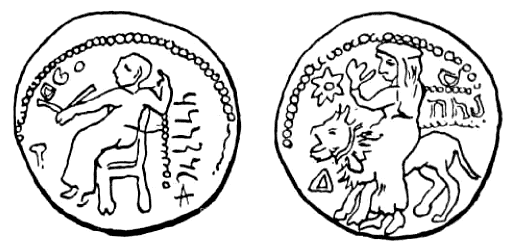
Fig. 94
To them, its swiftness was denoted by the four
horses that pulled it; the authors of the Book of Enoch knew better:
"The chariot of Shamash," it says, "was driven by the wind."
Examining the Roman and Greek traditions and beliefs, we have
arrived back at Sumer; we have circled back to Gilgamesh and his
Search for Immortality in the Cedar Forest, at the "crossroads of
Ishtar." Though in the territory of Adad, he was told, the place was
also within the jurisdiction of Shamash. And so we have the original
Triad: Adad, Ishtar, Shamash.
Have we come upon the Landing Place?
That the Greeks were aware of the epic adventures of Gilgamesh, few
scholars nowadays doubt. In their "investigation of the origins of
human knowledge and its transmission through Myth," entitled
Hamlet's Mill, Giorgio de Santillana and
Hertha von Deschend point
out that "Alexander was a true replica of Gilgamesh." But even
earlier, in the historic tales of Homer, the heroic Odysseus had
already followed similar footsteps. Shipwrecked after traveling to
the abode of Hades in the Lower World, his
men reached a place where they "ate the cattle of the Sun God" and
were therefore killed by Zeus.
Left alive alone, Odysseus wandered
about until he reached the "Ogygian island"—the secluded place from
pre-Deluge times. There, the Goddess Calypso, "who kept him in a
cave and fed him, wanted him to marry her; in which case she
intended making him immortal, so that he should never grow old." But
Odysseus refused her advances— just as Gilgamesh had turned down
Ishtar's offer of love.
Henry Seyrig, who as Director of Antiquities of Syria devoted a
lifetime to the study of the vast platform and its meaning, found
that the Greeks used to conduct there "rites of mystery, in which
Afterlife was represented as human Immortality—an identification
with the deity obtained by the ascent (heavenward) of the soul." The
Greeks, he concluded, indeed associated this place with Man's
efforts to attain Immortality.
Was then this place the very place in the Cedar Mountains to which
Gilgamesh had first gone with Enkidu, the Crest of Zaphon of Ba'al?
To give a definite answer, let us look more closely at the physical
features of the place. We will find that the Romans and Greeks have
built their temples upon a paved platform which existed from much
earlier times—a platform constructed of large, thick stone blocks so
tightly put together that no one—to this very day—has been able to
penetrate it and study the chambers, tunnels, caverns and other
substructures that lie hidden beneath it.
That such subterranean structures undoubtedly exist is judged not
only from the fact that other Greek temples had secret, subterranean
cellars and grottoes beneath their apparent floors. Georg Ebers and
Hermann Guthe (Palastina in Bild und Wort, the English version is
titled Picturesque Palestine) reported a century ago that the local
Arabs entered the ruins "at the southeast corner, through a long
vaulted passage like a railway tunnel under the great platform"
(Fig. 95).
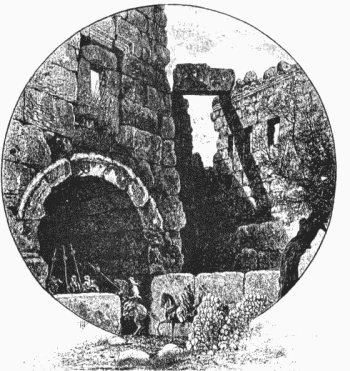
Fig. 95
"Two of these great vaults run parallel with each other,
from east to west, and are connected by a third running at right
angles to them from north to south."
As soon as they entered the
tunnel, they were caught in total darkness, broken here and there by
eerie green lights from puzzling "laced windows." Emerging from the
460-feet-long tunnel, they found themselves under the north wall of
the Sun Temple, "which the Arabs call Dar-as-saadi—House of Supreme
Blissful-ness."
The German archaeologists also reported that the platform apparently
rested upon gigantic vaults; but they concerned themselves with
mapping and reconstructing the superstructure. A French
archaeological mission, led by Andre Parrot in the 1920s, confirmed
the existence of the subterranean maze, but was unable to penetrate
its hidden parts. When the platform was pierced from above through
its thick stones, evidence was found of structures beneath it.
The temples were erected upon a platform raised to thirty feet,
depending on the terrain. It was paved with stones whose size, to
judge by
the slabs visible at the edges, ranged from a length of twelve feet
to thirty feet, a frequent width of nine feet and a thickness of six
feet. No one has yet attempted to calculate the quantity of stone
hewn, cut, shaped, hauled and imbedded layer upon layer upon this
site; it could possibly dwarf the Great Pyramid of Egypt.
Whoever laid this platform originally, paid particular attention to
the rectangular northwestern corner, the location of the temple of
Jupiter/Zeus. There, the temple's more than 50,000 square feet
rested upon a raised podium which was certainly intended to support
some extremely heavy weight. Constructed of layer upon layer of huge
stones, the Podium rose twenty-six feet above the level of the Court
in front of it and forty-two feet above the ground on its exposed
northern and western sides.
On the southern side, where six of the
temple's columns still stand, one can clearly see (Fig. 96a) the
stone layers: interspersed between sizable yet relatively
small stones, there are alternating rows of stone blocks measuring
up to twenty-one feet in length. One can also see (bottom left) the
lower layers of the Podium, protruding as a terrace below the raised
temple. There, the stones are even more gigantic.
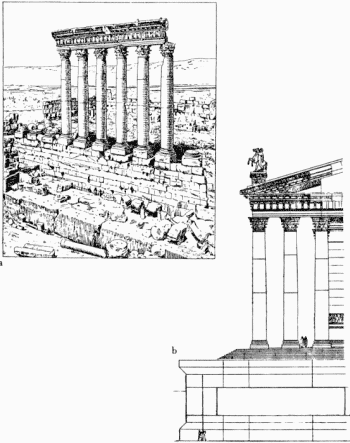
Fig. 96
More massive by far were the stone blocks in the western side of the
Podium. As shown in the schematic drawing of the northwestern corner
prepared by the German archaeological team (Fig. 96b), the
protruding base and the top layers of the Podium were constructed of
"cyclopian" stone blocks some of which measure over thirty-one feet
in length, about thirteen feet in height and are twelve feet thick.
Each such slab represents thus about 5,000 cubic feet of stone and
weighs more than 500 tons.
Large as these stones are—the largest ones in the Great Pyramid of
Egypt weigh 200 tons—they were not the largest slabs of granite
employed by the ancient master builder in creating the Podium.
The central layer—situated some twenty feet above the base of the
Podium—was incredibly made up of even larger stones. Modern
surveyors have spoken of them as "giant," "colossal," "huge."
Ancient historians named them the Trilithon—the Marvel of the Three
Stones. For there, exposed to view in the western side of the
Podium, lie side by side three stone blocks, the likes of which
cannot be seen anywhere else in the world.
Precisely shaped and
perfectly fitting, each of the three stones (Fig. 97) measures over
sixty feet in length, with sides of fourteen and twelve feet. Each
slab thus represents more than 10,000 cubic feet of granite and
weighs well over 1,000 tons!
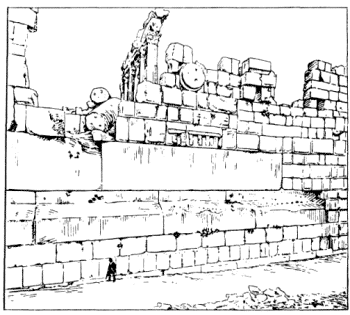
Fig. 97
The stones for the Platform and
Podium were quarried locally; Wood
and Dawkins include one of these quarries (Fig. 90) in their
panoramic sketch, showing some of the large stone blocks strewn
around in the ancient quarry. But the gigantic blocks were hewn, cut
and shaped at another quarry, situated in the valley some
three-quarters of a mile southwest of the sacred precinct. It is
there that one comes upon a sight even more incredible than that of
the Trilithon.
Partly buried in the ground, there lies yet another one of the
colossal granite slabs—left in situ by whoever the grand quarrier
was. Fully shaped and perfectly cut, with only a thin line at its
base still connecting it to the rocky ground, it is an unbelievable
sixty-nine feet long and has a girth of sixteen by fourteen feet. A
person climbing upon it (Fig. 98) looks like a fly upon a block of
ice.... It weighs, by conservative estimates, more than 1,200 tons.
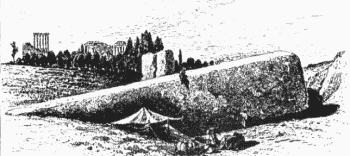
Fig. 98
Most scholars believe that it was intended to be hauled, as its
three sisters were, up to the sacred precinct and perhaps be used to
extend the terrace-part of the Podium on the northern side. Ebers
and Guthe record a theory that in the row beneath the Trilithon,
there are not two smaller slabs but a single stone akin to the one
found at the quarry, measuring more than sixty-seven feet in length,
but either damaged or otherwise chiseled to give the appearance of
two side-by-side stones.
Wherever the leftover colossal stone was intended to be placed, it
serves as a mute witness to the immensity and uniqueness of the
Platform and Podium nesting in the mountains of Lebanon. The
mind-boggling fact is that even nowadays there exists no crane,
vehicle or mechanism that can lift such a weight of 1,000-1,200
tons—to say nothing of carrying such an immense object over valley
and mountainside, and placing each slab in its precise position,
many feet above the ground. There are no traces of any roadway,
causeway, ramp or other earthworks that could even remotely
suggest the hauling or dragging of these megaliths from the quarry
to their uphill site.
Yet in remote days, someone, somehow had achieved the feat... .
But who? Local traditions hold that the place had existed from the
days of Adam and his sons, who resided in the area of the Cedar
Mountains after the expulsion of Adam and Eve from the Garden of
Eden. Adam, these legends relate, inhabited the place which is now
Damascus, and died not far from there. It was Cain his son who built
a refuge upon the Cedar Crest after he had killed Abel.
The Maronite Patriarch of Lebanon related the following tradition:
"The fastness on Mount Lebanon is the most ancient building in the
world. Cain, the son of Adam, built it in the year 133 of Creation,
during a fit of raving madness. He gave it the name of his son
Enoch, and peopled it with giants who were punished for their
iniquities by the Flood."
After the Deluge, the place was rebuilt by
the biblical Nimrod, in his efforts to scale the heavens. The
Tower
of Babel, according to these legends, was not in Babylon but upon
the great platform in Lebanon.
A seventeenth-century traveler named d'Arvieux wrote in his
Memoires
(Part II, Chapter 26) that local Jewish inhabitants, as well as
Muslim residents, held that an ancient manuscript found at the site
revealed that,
"After the Flood, when Nimrod reigned over Lebanon, he
sent giants to rebuild the Fortress of Baalbek, which is so named in
honor of Ba'al, the God of the Moabites, worshippers of the
Sun-God."
The association of the God Ba'al with the place in post-Diluvial
days strikes a bell. Indeed, no sooner were the Greeks and Romans
gone than the local people abandoned the Hellenistic name Heliopolis
and resumed calling the place by its Semitic name. It is the name by
which it is still called to this day:
Baalbek.
There are differing opinions as to the precise meaning of the name.
Many believe that it means "The Valley of Ba'al." But from the
spelling and from Talmudic references, we surmise that it has meant
"The Weeping of Ba'al."
We can hear again the closing verses of the Ugaritic epic,
describing the fall of Ba'al in his struggle with Mot, the discovery
of his lifeless body, his entombment by Anat and Shepesh in a grotto
upon the Crest of Zaphon:
They came upon Baal, fallen on the ground;
Puissant Baal is dead;
The Prince, Lord of Earth, is perished... .
Anat weeps her fill of weeping;
In the valley she drinks tears like wine.
Loudly she calls unto the Gods' Torch, Shepesh:
"Lift Puissant Baal, I pray,
lift him onto me."
Hearkening, the Gods' Torch Shepesh
Picks up Puissant Baal,
Sets him on Anat's shoulder.
Up to the Fastness of Zaphon she brings him;
Bewails him, entombs
him;
Lays him in the hollows of the earth.
All these local legends, which as all legends contain a kernel of
age-old recollections of actual events, agree that the place is of
extreme antiquity. They ascribe its building to "giants" and connect
its construction with the events of the Deluge. They connect it with
Ba'al, its function being that of a "Tower of Babel"—a place from
which to "scale the heavens."
As we look at the vast Platform, its location and layout, and ponder
the purpose of the immense Podium built to sustain massive weights,
the depiction on the coin from Byblos (Fig. 89) keeps flashing
before our eyes: a great temple, a walled sacred area, a podium of
extra-strong construction— and upon it the rocket-like Flying
Chamber.
The words and descriptions of the Hidden Place in the
Epic of
Gilgamesh also keep echoing in our ears. The insurmountable wall,
the gate which stuns whoever touches it, the tunnel to the
"enclosure from which words of command are issued," the "secret
abode of the Anunnaki," the monstrous Guardian with his "radiant
beam."
And there is no doubt left in our mind that in Baalbek we have found
Ba'al's Crest of Zaphon, the target of the first journey of
Gilgamesh.
The designation of Baalbek as "the Crossroads of Ishtar" implies
that, as she roamed Earth's skies, she could come and go from that
"Landing Place" to other landing places upon Earth. Likewise, the
attempt by Ba'al to install upon the Crest of Zaphon "a contraption
that launches words, a 'stone that whispers, "' implied the
existence elsewhere of similar communication units:
"Heaven with
Earth it makes converse, and the seas with the planets."
-
Were there indeed such other places on Earth that could serve as
Landing Places for the aircraft of the Gods?
-
Were there, besides
upon the Crest of Zaphon, other "stones that whisper"?
The first obvious clue is the very name "Heliopolis," indicating the
Greek belief that Baalbek was, somehow, a "City of the sun God"
paralleling its namesake city in Egypt. The Old Testament too
recognized the existence of a northern Beth-Shemesh ("House of
Shamash") and a southern Beth-Shemesh, On, the biblical name for
the
Egyptian Heliopolis. It was, the prophet Jeremiah said, the place of
the "Houses of the Gods of Egypt," the location of Egypt's obelisks.
The northern Beth-Shemesh was in Lebanon, not far from Beth-Anath
("House/Home of Anat"); the prophet Amos identified it as the
location of the "palaces of Adad ... the House of the one who saw
El." During the reign of Solomon, his domains encompassed large
parts of Syria and Lebanon, and the list of places where he had
built great structures included Baalat ("The Place of Ba'al") and
Tamar ("The Place of Palms"); most
scholars identify these places as Baalhek and Palmyra (see map, Fig.
78).
Greek and Roman historians made many references to the links that
connected the two Heliopolises. Explaining the Egyptian pantheon of
twelve Gods to his countrymen, the Greek historian Herodotus also
wrote of an "Immortal whom the Egyptians venerated as Hercules." He
traced the origins of the worship of this Immortal to Phoenicia,
"hearing that there was a temple of Hercules at that place, very
highly venerated." In the temple he saw two pillars.
"One was of
pure gold; the other was of emerald, shining with great brilliancy
at night."
Such sacred "Sun Pillars"—"Stones of the Gods"—were actually
depicted on Phoenician coins following the area's conquest by
Alexander (Fig, 99). Herodotus provides us with the additional
information that of the two connected stones, one was made of the
metal which is the best conductor of electricity (gold); and the
other of a precious stone (emerald) as is now used for laser
communications, giving off an eerie radiance as it emits a
high-powered beam. Was it not like the contraption set up by Ba'al,
which the Canaanite text described as "stones of splendor?"
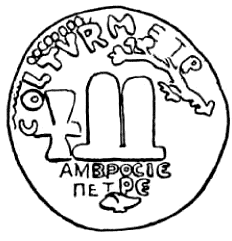
Fig, 99
The Roman historian Macrobius, writing explicitly about the
connection between the Phoenician Heliopolis (Baalbek) and its
Egyptian counterpart, also mentions a sacred stone; according to
him, "an object" venerating the Sun God Zeus Helioupolites was
carried by Egyptian priests from the Egyptian Heliopolis to
Heliopolis (Baalbek) in the north.
"The object," he added, "is now
worshipped with Assyrian rather than Egyptian rites."
Other Roman historians also stressed that the "sacred stones"
worshiped by the "Assyrians" and the Egyptians were of a conical
shape. Quintus Curtius recorded that such an object was located at
the temple of Ammon at the oasis of Siwa.
"The thing which is
worshipped there as a God," Quintus Curtius wrote, "has not the
shape that artificers have usually applied to the Gods. Rather, its
appearance is most like an umbilicus, and it is made of an emerald
and gems cemented together."
The information regarding the conical object worshiped at
Siwa was
quoted by F. L. Griffith in connection with the announcement, in
The
Journal of Egyptian Archaeology (1916), of the discovery of a
conical "omphalos" at the Nubian "pyramid city" of Napata. This
"unique Meroitic monument" (Fig. 100) was found by George A. Reisner
of Harvard University at the inner sanctum of the temple of Ammon
there—the southernmost temple to this God of Egypt.
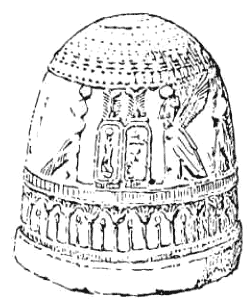
Fig. 100
The term omphalos in Greek or umbilicus in Latin means a "navel"—a
conical stone which, for reasons that scholars do not understand,
was deemed in antiquity to have marked a "center of the Earth.
The temple of Ammon at the oasis of Siwa, it will be recalled, was
the location of the oracle which Alexander rushed to consult on his
arrival in Egypt. We have the testimony of both Callisthenes,
Alexander's historian, and the Roman Quintus Curtius that an
omphalos made of precious stones was the very "object" venerated at
that oracle site. The Nubian temple of
Ammon where Reisner discovered the omphalos stone was at Napata, an
ancient capital of the domains of Nubian queens; and we recall the
baffling visit of Alexander to Queen Candace, in his continuing
quest for Immortality.
Was it mere coincidence that, in his search for the secrets of
longevity, the Persian king Cambyses (as Herodotus has reported)
sent his men to Nubia, to the temple where the "Table of the Sun"
was enshrined? Early in the first millennium B.C. a Nubian queen
—the Queen of Sheba —made a long journey to King Solomon in
Jerusalem. The legends current at Baalbek relate that he embellished
the site in Lebanon in her honor. Did she then undertake the long
and hazardous voyage merely to enjoy the wisdom of Solomon, or was
her real purpose to consult the oracle at Baalbek—the biblical
"House of Shemesh?"
There seem to be more than just coincidences here; and the question
that comes to mind is this: if at all these oracle centers an
omphalos was enshrined—was the omphalos itself the very source of
the oracles?
The construction (or reconstruction) upon the Crest of Zaphon of a
launching silo and a landing platform for Ba'al was not the cause of
his fatal battle with Mot. Rather, it was his clandestine attempt to
set up a "Stone of Splendor." This device could communicate with the
heavens as well as with other places on Earth.
But, in addition, it
was,
A stone that whispers;
Men its messages will not know,
Earth's
multitudes will not comprehend.
As we ponder the apparent dual function of the
Stone of Splendor,
the secret message of Ba'al to Anat all of a sudden becomes clear:
the same device which the Gods used to communicate with each other
was also the object from which there emanated the Gods' oracular
answers to the kings and heroes!
In a most thorough study on the subject, Wilhelm H. Roscher
(Omphalos) showed that the Indo-European term for these oracle
stones— navel in English, nabel in German, etc.—stem from the
Sanskrit nabh, which meant "emanate forcefully.'' It is no
coincidence that in the Semitic languages naboh meant to foretell
and nabih meant "prophet." All these identical meanings undoubtedly
harken back to the Sumerian, in which NA.BA(R) meant "bright-shiny
stone that solves."
A veritable network of such oracle sites emerges as we study ancient
writings. Herodotus—who accurately reported (Book II, 29) the
existence of the Meroitic oracle of Jupiter-Ammon—added to the links
we have so far discussed by stating that the "Phoenicians," who
established the oracle at Siwa, also established the oldest oracle
center in Greece, the one at Dodona —a mountain site in northwestern
Greece (near the present Albanian border).
To that effect, he related a report he had heard when he visited
Egypt, whereby,
"two sacred women were once carried off from Thebes
(in Egypt) by the Phoenicians ... one of them was sold into Libya
(western Egypt) and the other into Greece. These women were the
first founders of the oracles in the two countries."
This version,
Herodotus wrote, he heard from the Egyptian priests of Thebes. But
at Dodona, the version was that "two black doves flew away from the
Egyptian Thebes," one alighting at Dodona and the other at Siwa:
whereupon an oracle of Jupiter was established at both places, the
Greeks calling him Zeus at Dodona and the Egyptians Ammon at Siwa.
The Roman historian Silicus Italicus (first century A.D.), relating
that Hannibal consulted the oracle at Siwa regarding his wars
against Rome, also credited the flight of the two doves from Thebes
with the establishment of the oracles in the Libyan desert (Siwa)
and in Greek Chaonia (Dodona). Several centuries later, the Greek
poet Nonnos, in his master work Dionysiaca, described the oracle
shrines at Siwa and Dodona as twin sites, and held that the two were
in voice communication with each other:
Behold the new-found answering voice
of the Libyan Zeus!
The thirsty
sands an oracular sent forth
to the dove at Chaonia [= Dodona].
As far as F. L. Griffith was concerned, the discovery of the
omphalos in Nubia brought to mind another oracle center in Greece.
The conical shape of the Nubian omphalos, he wrote, "was precisely
that of the omphalos at the oracle at Delphi."
Delphi, the site of Greece's most famous oracle, was dedicated to
Apollo ("He of Stone"); its ruins are still one of Greece's leading
tourist attractions. There too, as at Baalbek, the sacred precinct
consisted of a platform shaped upon a mountainside, also facing a
valley that opens up as a funnel toward the Mediterranean Sea and
the lands on its other shores.
Many records establish that an omphalos stone was Delphi's holiest
object. It was set into a special base in the inner sanctum of the
temple of Apollo, some say next to a golden statue of the God and
some say it was enshrined all by itself. In a subterranean chamber,
hidden from view by the oracle seekers, the oracle priestess, in
trance-like oblivion, answered the questions of kings and heroes by
uttering enigmatic answers—answers given by the God but emanating
from the omphalos.
The original sacred omphalos had mysteriously disappeared, perhaps
during the several sacred wars or foreign invasions which affected
the place. But a stone replica thereof, erected perhaps in Roman
times outside the temple, was discovered in archaeological
excavations and is now on display in the Delphi Museum (Fig. 101).
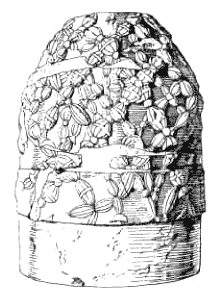
Fig.101
Along the Sacred Way leading up to the temple, someone, at some
unknown time, also set up a simple stone omphalos in an effort to
mark the place where oracles were first given at Delphi, before the
temple was built.
The coins of Delphi depicted Apollo seated on this omphalos (Fig.
102); and after Phoenicia fell to the Greeks, they likewise depicted
Apollo seated upon the "Assyrian" omphalos. But just as frequently,
the oracle stones were depicted as twin cones connected to each
other via a common base, as in
Fig. 99.
How was Delphi chosen as a sacred oracle place, and how did the
omphalos stone come to be there? The traditions say that when Zeus
wanted to find the center of the Earth, he released eagles from two
opposite ends of the world. Flying toward each other, they met at
Delphi; whereupon the place was marked by erecting there a navel
stone, an omphalos. According to the Greek historian Strabo, images
of two such eagles were perched on top of the omphalos at Delphi.
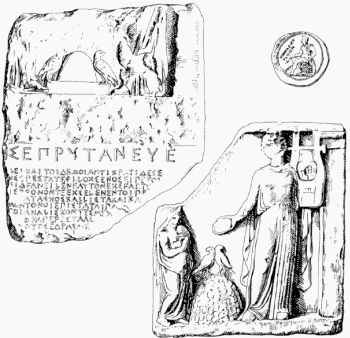
Fig. 102
Depictions of the omphalos have been found in Greek art, showing the
two birds atop or at the sides (Fig. 102) of the conical object.
Some scholars see in the birds not eagles, but carrier pigeons,
which—being able to find
their way back to a certain place—might have symbolized the
measuring of distances from one Center of Earth to another.
According to Greek legends, Zeus found refuge at Delphi during his
aerial battles with Typhon, resting on the platform-like area upon
which the temple to Apollo was eventually built. The shrine to Ammon
at Siwa contained not only subterranean corridors, mysterious
tunnels and secret passages inside the temple's thick walls, but
also a restricted area of some 180 by 170 feet, surrounded by a
massive wall.
In its midst, there arose a solid stone platform. We
find the same structural components, including a raised platform, in
all the sites associated with the "stones that whisper." Is one to
conclude, then, that as the far larger Baalbek was, they too were
both a Landing Place and a Communications Center?
Not surprisingly, we find the twin Sacred Stones, accompanied by the
two eagles, also depicted in Egyptian sacred writings (Fig. 103);
and many centuries before the Greeks even began to enshrine their
oracle centers, an Egyptian Pharaoh depicted an omphalos with the
two perched birds in his pyramids.

Fig.103
He was Seti I, who lived in the
fourteenth century B.C.; and it was in his depiction of the domain
of Seker, the Hidden God, that we have seen the oldest omphalos to
date—in
Fig. 19. It was the communications
means whereby messages—"words"—"were spoken to Seker every day."
In Baalbek, we have found the target of the first journey of
Gilgamesh. Having followed the threads connecting the "whispering"
Stones of Splendor, we arrived at the Duat.
It was the place where the Pharaohs sought the Stairway to Heaven
for an Afterlife. It was, we suggest, the place whereto Gilgamesh,
in search of Life, set his course on his second journey.
Back to
Stairway to Heaven
or
Back to Baalbek - A Colossal Enigma
|














